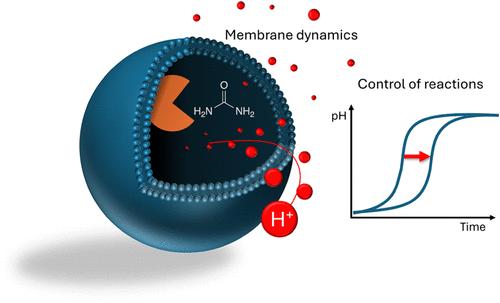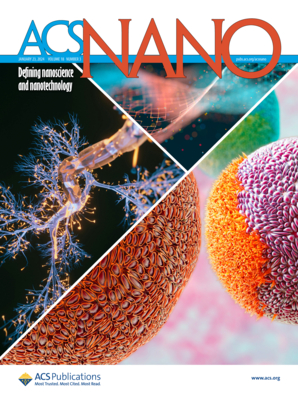Membrane Transport Modulates the pH-Regulated Feedback of an Enzyme Reaction Confined within Lipid Vesicles
IF 15.8
1区 材料科学
Q1 CHEMISTRY, MULTIDISCIPLINARY
引用次数: 0
Abstract
Understanding ion transport dynamics in reactive vesicles is pivotal for exploring biological and chemical processes and essential for designing synthetic cells. In this work, we investigate how proton transport and membrane potential regulate pH dynamics in an autocatalytic enzyme reaction within lipid vesicles. Combining experimental and numerical methods, we demonstrate that compartmentalization within lipid membranes accelerates internal reactions, attributed to protection from the external acidic environment. In experiments, we explored how proton movement significantly impacts internal reactions by changing bilayer thickness, adding ion transporters, and varying buffers. Numerical investigations incorporated electrical membrane potential and capacitance into a kinetic model of the process, elucidating the mechanisms that dictate the control of reaction time observed in the experiment, driven by both electrical and chemical potential gradients. These findings establish a framework for controlling pH clock reactions via membrane changes and targeted manipulation of proton movement, which could aid in the design of synthetic cells with precise, controlled functionalities.

求助全文
约1分钟内获得全文
求助全文
来源期刊

ACS Nano
工程技术-材料科学:综合
CiteScore
26.00
自引率
4.10%
发文量
1627
审稿时长
1.7 months
期刊介绍:
ACS Nano, published monthly, serves as an international forum for comprehensive articles on nanoscience and nanotechnology research at the intersections of chemistry, biology, materials science, physics, and engineering. The journal fosters communication among scientists in these communities, facilitating collaboration, new research opportunities, and advancements through discoveries. ACS Nano covers synthesis, assembly, characterization, theory, and simulation of nanostructures, nanobiotechnology, nanofabrication, methods and tools for nanoscience and nanotechnology, and self- and directed-assembly. Alongside original research articles, it offers thorough reviews, perspectives on cutting-edge research, and discussions envisioning the future of nanoscience and nanotechnology.
 求助内容:
求助内容: 应助结果提醒方式:
应助结果提醒方式:


